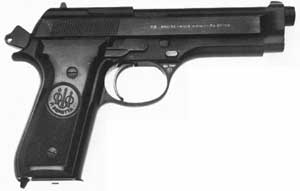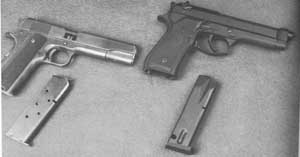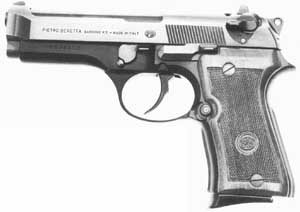(Data refers to Model 92F/M9)
Nation of origin: Italy
Ammunition: 9 x 19mm
Operation: short recoil
Weight: loaded, 1.145 kg
Length: 217 mm
Length of barrel: 125 mm
Magazine capacity: 15 rounds
Muzzle t approx 390 m/s
Beretta pistols have for long enjoyed an enviable reputation for all-round quality and for having superb shooting characteristics. They have also managed to maintain a distinctive appearance that marks them as Beretta products, despite the large number of models that have been developed over the years. When the Beretta Model 92 appeared in the mid-1970s it was immediately recognizable as a Beretta, even though it was much larger than the usual run of Beretta ‘pocket pistols’ that had done so much to establish the company name and reputation.

The basic Beretta Model 92 from which all the subsequent
Model 92 variants have been derived.
One of the main recognition points on Beretta pistols is the long cut-away section over the barrel, combined with a wrap- over guide close to the muzzle to carry the fore sight. This was carried over to the Model 92, as was the general aura of careful design and good lines. The Model 92 was a large pistol, as it had to fire the 9mm Parabellum cartridge. Locking was achieved using the short recoil system.
The Model 92 was soon adopted by the Italian armed forces, where the 15-round capacity of the box magazine was much appreciated. Brazil was another satisfied customer. But the Model 92 was only the Start of a Series of pistol models to which new variants are apparently constantly being added. First to appear was the Model 92 S which had a modified safety. Then came the Model 92 SB which had several features to make it more suitable for left-handed users, and the safety mechanism was revised. This was followed by the Model 92 SB-C which was a scaled- down version of the Model 92 SB.

The Beretta Model 92S, a pistol closely allied to the Model
92F.

The 9 mm Beretta Model 92F, one of the most successful pistol
designs of recent years.
However we will concentrate on one particular variant of the Model 92 SB, the Model 92F. The Model 92F was developed specifically to meet a requirement issued by the United States Army to replace their venerable Colt M1911 series of pistols. These veterans had been in American service since 1911 and were well outdated if not just about worn out, many having been rebuilt using spare parts several times during their military careers. Over the years a virtual separate industry had grown to keep the massive numbers of M1911s supplied with spares, ac developments elsewhere overtook the American pistol industry. Although the fact was not immediately discernable under the welter of new pistol designs that constantly issued from American pistol manufacturers large and small, the big American names such as Colt and Smith & Wesson were gradually being left behind in all manner of pistol innovation such as inherent safeties, improved handling features, new materials and, perhaps the most important, new ammunition. While the 9 mm Parabellum cartridge could hardly be called new, it was virtually unknown within the United States other than from imports. American producers and users continued to select the trusted 0.45 ACP (Automatic Colt Pistol) cartridge used in the M1911. Almost every other military user elsewhere turned to the 9 mm Parabellum and the round became a NATO standard item. The American forces simply had to change, so the US Army issued a requirement for a new 9 mm pistol, the XM9, during the late 1970s. Their specification took account of all the improvements already built into many modern European pistols, and it caught American manufacturers on the hop.
Pistol development is a time-consuming business and it was too late when the Americans realized that their existing products could not easily meet the XM9 specifications. When the first ‘shoot-off’ competition took place, the result was that the contest was dominated by European manufacturers. However, none of accessories and other services to the point where design the entrants was deemed successful. Many considered the con test to have been rigged to favor the American entries, but as none of them got through the selection process either, the result was yet another competition, held during 1984. Once again the Europeans dominated the proceedings, to the point where at the end of it all two European entrants were selected and one of them was finally adjudged the ‘winner’, apparently by being the least expensive product of the two.
The winner was the Beretta Model 92F, the variant of the Model 92 SB developed specifically for the US Army contest. It is now the M9 Pistol and is in production both in the United States and Italy to meet an initial production contract for 315,930 pistols at an initial cost of $53 million that works out at $175 each, which is just over a quarter of the commercial price. The M9s will be delivered over a five-year period, with initial production being delivered direct from Italy. After an interim changeover period, all production will be carried out in the United States.

The old and the new; on the left is the old Colt .45 M1911
‘Government Model’, while on the right is the pistol that will replace
it as the US Armed Forces’ standard service pistol, the Beretta Model
92F, or M9 (US Army).
The M9 differs from the Model 92 SB in having a revised trigger guard outline plus an extended magazine butt to accommodate a two-handed grip, a lanyard ring at the base of the butt, a chromed barrel and revised grip plates. The pistol is finished with a film of a hard plastic-like material known as ‘Bruniton’ that reduces glare and resists wear.
It would be foolish to state that the American pistol industry has taken the award of the M9 contract to Beretta without demur. At the time of writing, there was still talk of legal action, contest reruns and a general air of discontent that a ‘foreign’ concern should take a contract that historically should have gone to an American company. But the Italians did get the contract and are sticking to it by opening a production line in the United States (at Accokeek, Maryland). Although their contract was won mainly on cost grounds over their Swiss competitors (SIG, with the P226 — q.v.), the award of the M9 contract has meant that many other potential Beretta users are making their way to the Beretta headquarters at Brescia to order the Model 92F, or something like it, for their own armed forces and other agencies.

The Beretta Model 92F Compact, a slightly revised version
of the basic Model 92F.
They have plenty of models to choose from. There is now a Model 92F Compact, a Model 92 SB—C Type M, which is a revised version of the Model 92 SB-C, and various Model 92 derivatives chambered for the 7.65 x 21 mm Parabellum round. But overall the most important model in numerical terms is the Model 92F. If the Model 92F/M9 is good enough to meet the stringent specifications and selection procedures of the American armed forces, it should be good enough to meet just about any military requirement.
Beretta have produced another winner.

The Beretta Model 99, a 7.65 mm version of the Model 92SB-C,
just one of the many variants of the basic Beretta Model 92.
Prev: Desert Eagle
Next: Beretta 93R (coming soon)